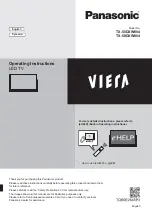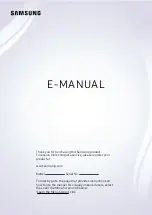
Cable-TV Operation
Your new TV is designed to receive up
to 181 channels in the U.S.A. including
125 non-scrambled cable channels (see
chart below). To use this TV on a cable-
TV system, confirm that the cable-TV
system is properly connected to your TV.
Since cable systems vary, you may wish
to consult your local cable-TV company
for additional information.
If your cable-TV company follows
EIA/NCTA channel-identification
standards, most of the channels offered
by your cable company will be identified
by channel numbers that are identical to
those on your TV. For example, if your
cable-TV system has programs on cable
channel 20, you can choose this channel
by selecting channel 20 on your TV.
If your cable company offers cable
channels 90, 91, or 92 you can tune them
by selecting the TV channels shown
below.
If your cable
company offers
this cable
channel:
Tune your TV
to this channel:
90
91
92
126
127
128
*
*
*
* To tune cable channels 100 through
128, press and hold number button 1
until 1-- appears on the screen. Then
enter the other two numbers.
Some cable-TV companies do not follow
the EIA/NCTA standards and instead
assign their own channel identification.
For example, some use the standard
broadcast channel numbers (2-13) for
channels 2-13, but identify their other
channels with letters. If your cable
company does not follow the EIA/NCTA
standards, ask them for a cross reference
that shows to which channels you should
tune your TV to receive their cable-TV
channels.
Not all cable-TV channels will be active
on your particular cable-TV system.
Also some cable companies may require
the use of a decoder with their cable-TV
system. Consult your cable company or
local dealer for details.
Scrambled Cable-TV Channels
Some cable companies offer “premium-
pay” channels in which the signal is
scrambled. Descrambling these signals
for normal viewing requires the use of a
descrambler device (cable box) which is
generally provided by the cable
company.
How you connect the cable box to your
TV depends upon whether or not the
cable box can be controlled by remote
control. The TV’s remote can also
control most brands of cable boxes, so if
your cable box is remote controllable,
you may want to connect it as shown in
Diagram B on page 30 or Diagram D on
page 31. Instructions for programming
the TV’s remote to control the cable box
are on page 32.
If your cable box cannot be controlled by
remote control, you will still be able to
remotely control “unscrambled”
channels with the connection shown in
Diagram C on page 30 or Diagram D on
page 31.
Since cable systems vary, you may wish
to consult your local cable company for
additional information.
The chart below lists the “total” channel and cable count.
• Low VHF A-8 (Channel 01)
• VHF (Channels 2-13)
• UHF (Channels 14-69)
• Low Midband A-5 thru A-1 (Channels 95-99)
• Midband (Channels 14-22 or A-I)
• Superband (Channels 23-36 or J-W)
• Hyperband (Channels 37-64 or W+1 to W+28)
• Ultraband (Channels 65-94 and 100-125 or
Total
1
12
—
5
9
14
28
56
Cable
Off
Air
Channels
—
12
56
—
—
—
—
68
—
125
W+29 to W+84)
**
**
**
**
***
***
** VHF is only counted once in total channel count because you can receive channels 2-13 on
both “off-air” and “cable” channels. Therefore the total channel count for “off-air” and
“cable” is 181 channels (68+125-12=181).
*** Channels 95, 96, and 97 are not applicable in Canada. Therefore the total number of
channels for Canada is 178 (68+122-12=178).
33
















































